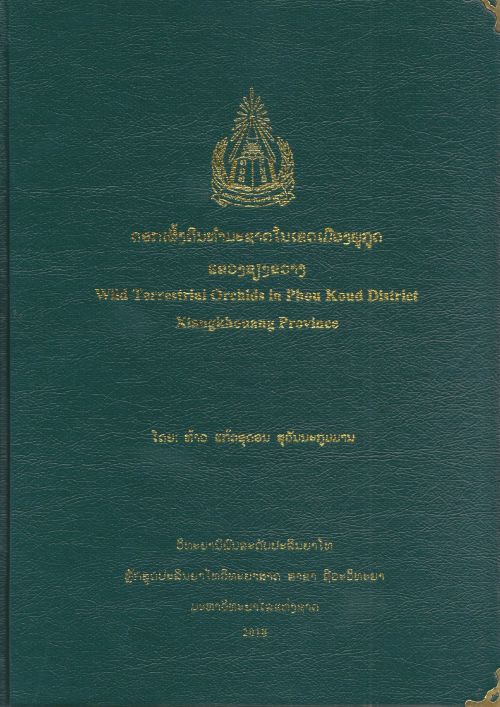
Terrestrial orchids in 10 villages of Phou Koud district, Xiangkhouang province were studied from March, 2016 to March, 2018. Thirty two (32) species of 22 genera were found and identified; they are included within 2 sub-family, Epidendroideae and Orchidoideae. For Epidendroideae sub-family 16 genera were found with 23 species and for Orchidoideae 6 genera were found with 9 species, among those 4 species are new records to flora of Laos. Their scientific names, botanical descriptions, ecosystems and habitats, flowering and fruiting seasons, traditional uses, local names, illustration and photographs were supplied. Total of 53 numbers and 90 duplicates of voucher specimens and spirit samples were taken at Herbarium of Biology department, Faculty of Natural sciences, Nationbal University of Laos, and also were distributed to National Herbarium of Laos and PTK BG. Fifty (50) sampling plots were set up and were observed, total of 405 individual particular species were recorded. The result shows the highest density species is Anoectochilus burmannicus which are 82 records and were found in 9 villages, its index shannon-weiner is 0.3233 and its density is 162 leafy/ha; the highest diversity of terrestrial orchids was found in Bane Lae Thong with its Shannon-Weiner index of 2,976, and the lowest found in Bane Xiang Dead which is 1,722. Based on traditional knowledge of local uses by interview healers, local people and traders, twenty eight (28) species of terrestrial orchids were used as for food, ornamental and medicinal purposes. The last use was so diverse such as for caring diabetes, fracture, wound healing, skin disease, urination, health recovery, tuberculosis, anticancer, antimalaria, analgesic, antitoxin/antipyretic and reducing kidney stone. The soil quality that were tested in each sampling plots has presented 2 levels as the low nutrition is N = 50 ppm, P = 4 ppm, K = 50 ppm which was found in 12 sampling plots at around 24% of the total sampling plots and the median nutrition is N = 50–200 ppm, P = 4–14 ppm, K = 50–200 ppm that was found in 38 sampling plots (=76%), however, the high soil quality (N = 200 pmm, P = 14 ppm, K = 200 ppm) was not found in this studied sites. The pH of soil is 6.70 to 6.9 in 32 sampling plots (64%), pH 6.10–6.60 in 13 sampling plots (26%) and pH 7.00–7.20 is in 5 sampling plots (10%). The soil temperature is from 16°C to 32 °C (temperature average is 23°C). Based on marketing chain records, two (2) commercial species were presented as A. burmannicus and A. chapaensis, its prices is sharply increase up to 4 times from 350,000 LAK/fleshy kg to 500,000–1,200,000 LAK/fleshy kg, in the opposite hand, its populations reduce very quickly up to 10 times and should be very rare and/or extinct species. The threats are mainly over harvesting by local people for commercial purposes, its habitats are degraded and climate changes. Now a day, its diversity conservation was promoted and was managed by land use planning management and propagation learning and testing for commercial purpose.
